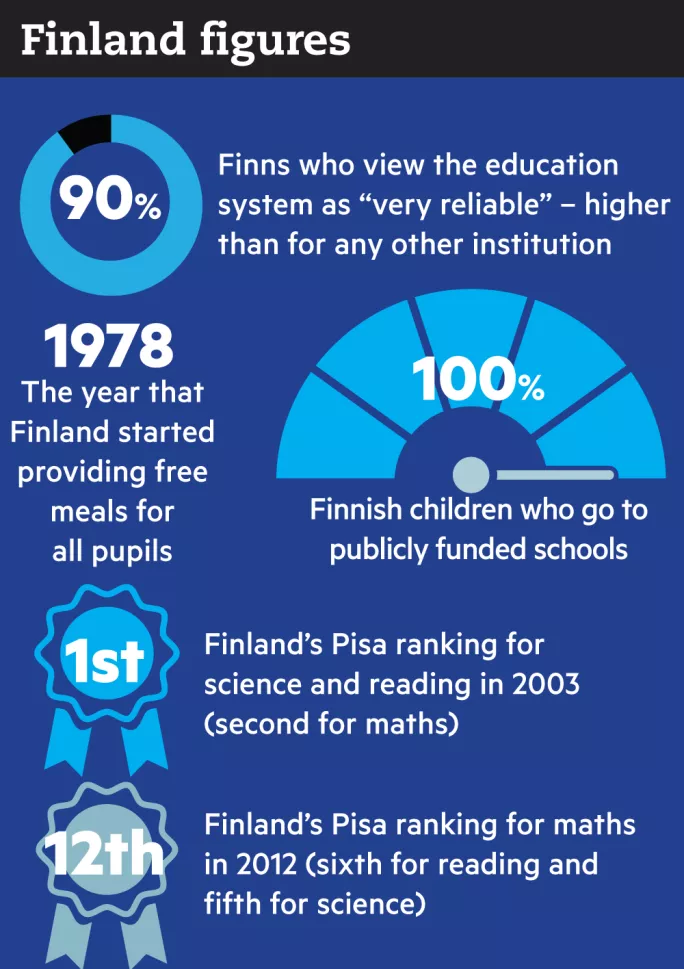
How to improve schools...from start to Finnish

The scene is familiar to many teachers in Finland: yet another group of foreign visitors shuffling around their school, in search of an educational elixir. A common reaction - which I see as I explore Helsinki classrooms for myself - is quiet bemusement.
Finland has long soared high in international measures of educational success such as the United Nations’ Education Index and the Programme for International Student Assessment (Pisa). It also holds an appeal for those with a progressive idea of education, owing to its credo of equality (all children go to publicly-funded schools), distrust of standardised tests and abolition of school inspection in the 1980s. The nation’s view of teaching as a highly prestigious, master’s-level profession is attractive, too - a 2013 survey of 22 countries suggested that only South Koreans valued teaching more highly.
It’s an alluring tale: the forward-thinking education system that propelled a once little-known country on the fringes of Europe on to the international stage.
Finns, however, tell a far more nuanced story. Even when they were soaring highest in the 2003 Pisa results - coming first in both science and reading and second in maths - one government adviser told me that a common reaction was: “Are we that good? Then how bad are the others, really?”
Part of that may be down to Finns’ national character - they tend to be modest and wary of show-offs - but there was also recognition that Pisa wasn’t a definitive measure of educational success.
‘Beloved’ education system
In the past, experts have pointed out that Finnish success could be attributed in part to a relatively homogeneous society, and said that it would be tested by immigration.
Sure enough, the Ministry of Education and Culture recently described the skill level of new arrivals as a “major concern”. The global economic crash, unleashed in 2008, is also testing Finns’ commitment to the generous welfare state that underpins comprehensive schools.
However, Finns retain quite remarkable trust and pride in their education system, which special government adviser Ilkka Turunen described in a recent presentation as “their beloved”. In a 2014 survey, 90 per cent rated it as “very reliable”, higher than for any other institution. Another survey, released in 2012, found that the introduction of comprehensive education in the 1970s was considered the most important event in Finnish history, well ahead of universal suffrage and the devastating 1939-40 war with the Soviet Union.
In Helsinki last month, Turunen told me about several emerging difficulties for Finnish education, including a “dramatic drop” in literacy and numeracy, a growing skillsbased gender gap and the expectation that attainment, after a decades-long rise, would start wobbling around 2020.

Meanwhile, Finland is expected to fall in the Pisa rankings again when the 2015 results are published later this year. Yet the country is not obsessed by Pisa, as was made abundantly clear by a breezy tweet from @thisisFINLAND, a marketing arm of the Ministry for Foreign Affairs: “The new core curriculum might knock #Finland off the top of the Pisa rankings for #education, but who cares!”
This is not flippancy: Finland remains deadly serious about education, but priorities are changing. The government envisages new methods of teaching and learning tailored to a fast-changing digital world: “The most important goal is to teach young people the skills they need in the future.” Interdisciplinary, flexible learning is a central plank of the new curriculum, and schools are being built “free of corridors” so that different subjects are encouraged to work together.
Coding now has a pivotal role, and student teachers will receive training in digital skills. Despite an economy that has long vaunted technology (think Nokia and Angry Birds), concerns abound about a failure to exploit this in classrooms. Turunen says that if Finnish schools cling to the analogue world (for all the country’s reputation for innovation, you’re still likely to see pupils sitting at rows of wooden desks ploughing through worksheets), they risk alienating a generation of children.
From success to complacency
You will not encounter boundless optimism among Finnish teachers. Taneli Nordberg, an English and French teacher at Norssi, a school in Helsinki, feels that Pisa success may have led to complacency: “I think we have lost focus - what made [Finnish education] special was that we didn’t think it was special.”
He fears that right-wing forces, calling for more educational choice, were quelled only by Pisa success. If Finland’s ranking slips, he fears that pressure will re-emerge.
Another Helsinki teacher, Dr Tapani Saarinen, is wary of overblown claims for the new curriculum, recalling educational fads in Finland, such as cooperative learning, which were supposed to “change everything” but died away.
However, as he surveys three 13-year-old pupils working on robotics, he sees signs of necessary modernisation: “If there is something in this new curriculum that will boost the future, it’s this emphasis on coding.”
The focus on teaching children to reason and debate is an important development and essential to democratic society, he adds.
Those searching for Finnish education’s secrets should look to what Anneli Portman, a University of Helsinki social psychologist, describes as an “amazingly strong” philosophy of equality, rather than some pedagogical box of tricks; she sees education and equality as the twin pillars of Finnish culture.
But Portman fears that cuts will “change the face of Finnish education” by opening up a divide between the wealthy and the poor.
You need a Tes subscription to read this article
Subscribe now to read this article and get other subscriber-only content:
- Unlimited access to all Tes magazine content
- Exclusive subscriber-only stories
- Award-winning email newsletters
- Unlimited access to all Tes magazine content
- Exclusive subscriber-only stories
- Award-winning email newsletters
You need a subscription to read this article
Subscribe now to read this article and get other subscriber-only content, including:
- Unlimited access to all Tes magazine content
- Exclusive subscriber-only stories
- Award-winning email newsletters
- Unlimited access to all Tes magazine content
- Exclusive subscriber-only stories
- Award-winning email newsletters